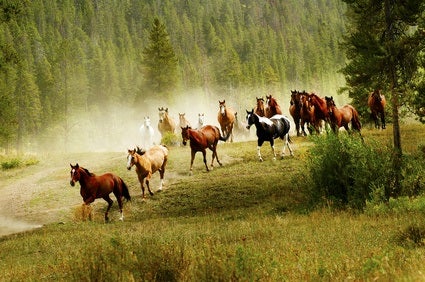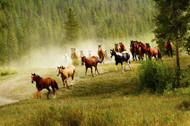Wild Horses in America
Dec 5th 2018
 There are few images that represent the American spirit better than wild mustangs. Freedom, toughness, tenacity, romance, and beauty: wild horses embody all of the things that Americans associate with the birth and growth of our nation. It might be surprising, therefore, to learn that the wild horses of today's American West are not descended from native horses at all. At least not directly.
There are few images that represent the American spirit better than wild mustangs. Freedom, toughness, tenacity, romance, and beauty: wild horses embody all of the things that Americans associate with the birth and growth of our nation. It might be surprising, therefore, to learn that the wild horses of today's American West are not descended from native horses at all. At least not directly.
The Evolution and Migration of the North American Horse
The first true horses like those that we have today, Equus caballus, appeared in North America about a million years ago. They evolved from ancestors that looked nothing like horses and were the size of small foxes. From North America, Equus Caballus migrated over land bridges into South America, Europe, Asia, and Africa (Edwards, 1995).
Extinction of the North American Horse
Sometime during or just after the last ice age, around 8,000-11,000 years ago, Equus caballus went extinct in North America. Because horses had migrated to other continents before the land bridges disappeared, they continued to evolve and grow there, but there were no longer any native horses in America. This is why the wild horses in the Western United States today are not directly descended from Native American horses at all. Rather, the horse was brought back to America from Europe in the 16th century by Spanish conquistadors, such Cortez (Edwards, 1995).
Reverting to the Wild
The wild horses, or mustangs, in America's Western states today are descendants of animals that escaped or were released from the cattle ranches of early Spanish settlers in the 1500s. This means that the horses were not truly "wild," but actually "feral" (domestic animals finding themselves back in nature). In the 1850s, there were around two million mustangs in America. Hunters, mostly selling them to pet food companies, had caused the numbers of mustangs to fall drastically by the mid 1970s.
Today's Wild Mustangs
In 1971, legislation was passed to help preserve America's mustangs. Today, the Bureau of Land Management (BLM) is charged with "maintaining a balance between the needs of ranching, recreation, and wildlife." Horses are caught, held, and sometimes adopted out to preserve enough range land for ranchers.
More than half of the wild horses in America today live in Nevada. There are some in Montana, Wyoming, Oregon, Utah, California, North Dakota, New Mexico, Arizona, and Idaho. There are also populations on several Atlantic islands.
Debates About Wild Horses
As is the case with many issues, there is disagreement over the best way to deal with America's wild horses. Some believe that, since they are not truly from native stock, the horses are an invasive species using up resources and should all be removed. Others believe that they deserve to keep their place in America's West, whether they are direct descendants of animals that evolved there or not. One thing seems certain: America's wild horse has had a history filled with struggle, beauty, freedom, oppression, and survival. Just like America itself.
Works Cited
America's Wild Horses. (n.d.). Retrieved from Wildlife Land Trust: https://www.hswlt.org/wildlife/close-ups/mustang-wildlife-close-up.html
Edwards, E. H. (1995). Wild Horses: A Spirit Unbroken. Stillwater: Voyageur Press, Inc.
Ginsburg, J. (2001, October 26). U.S. Wild Horses: Too Many Survivors on Too Little Land? Retrieved from National Geographic News: https://news.nationalgeographic.com/news/2001/10/1024_TVmustangs.html

